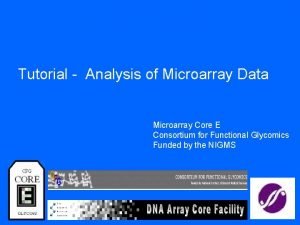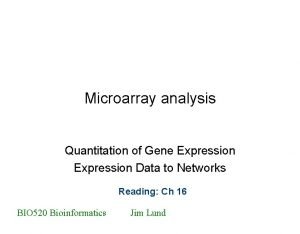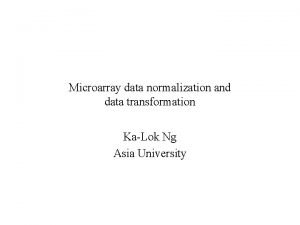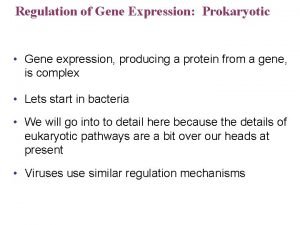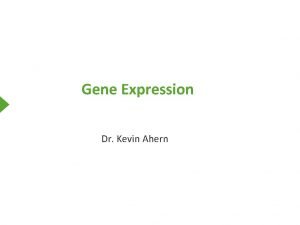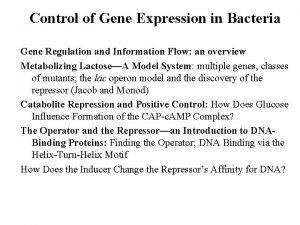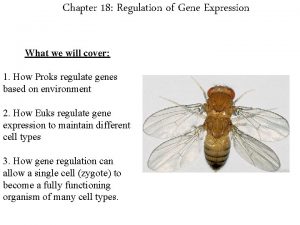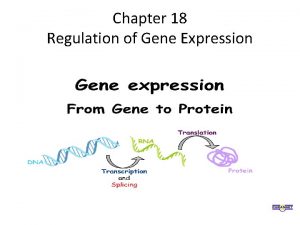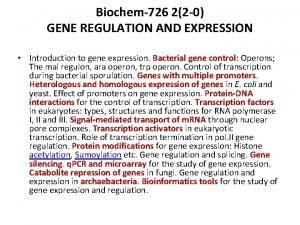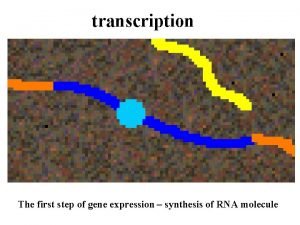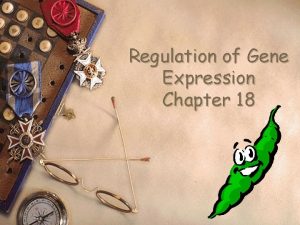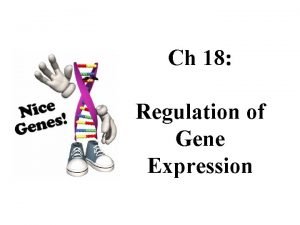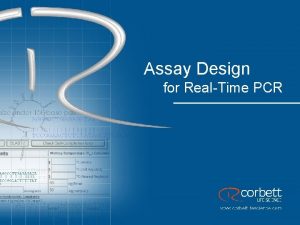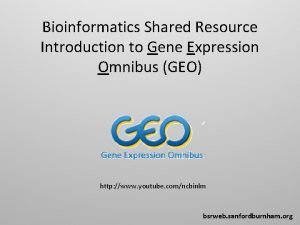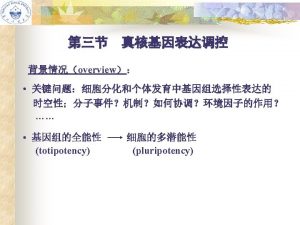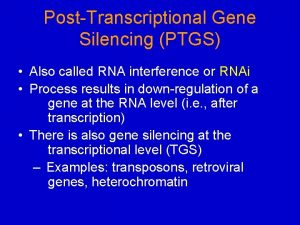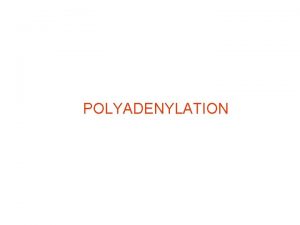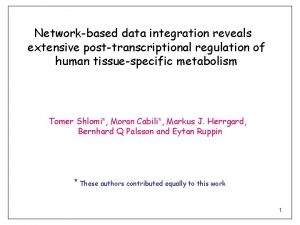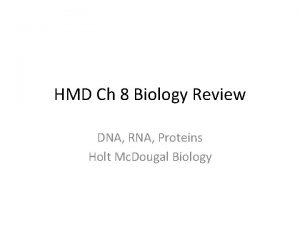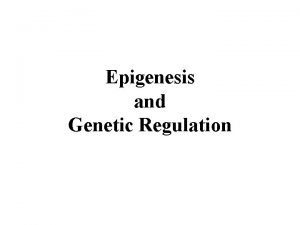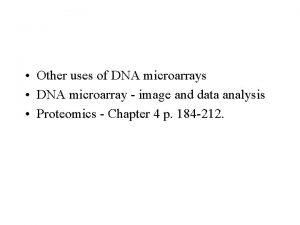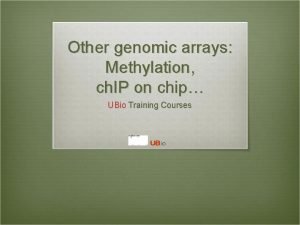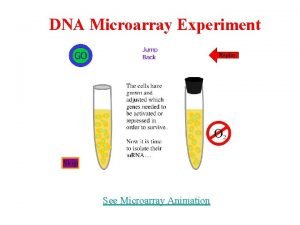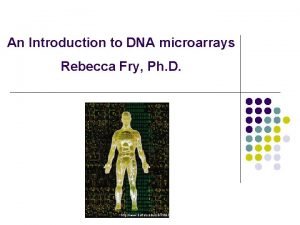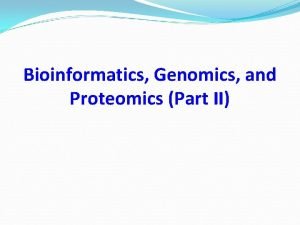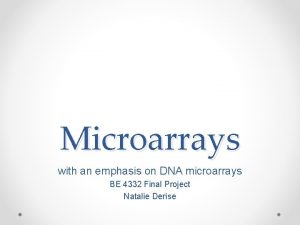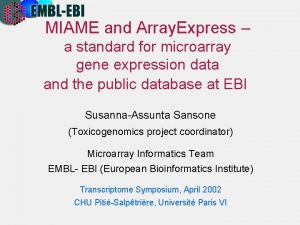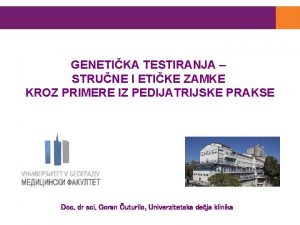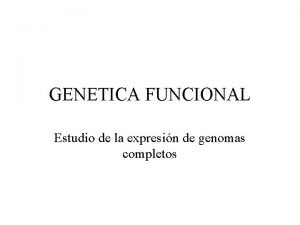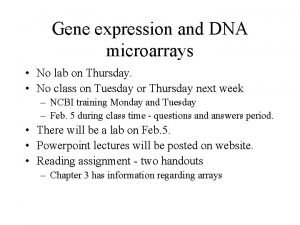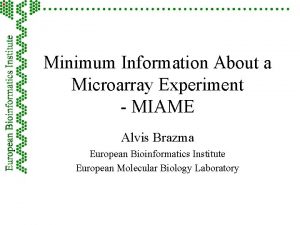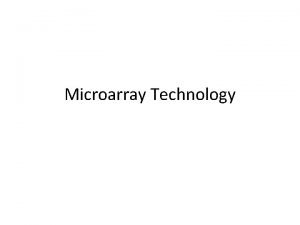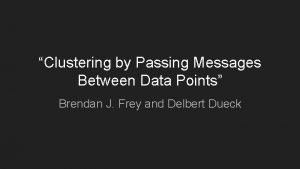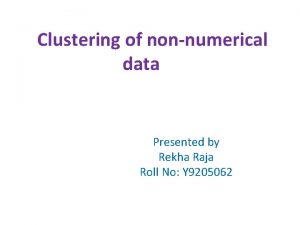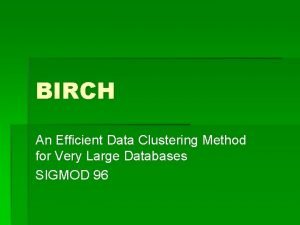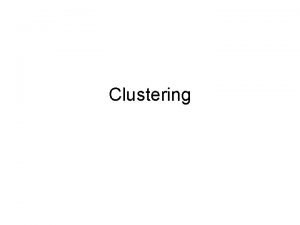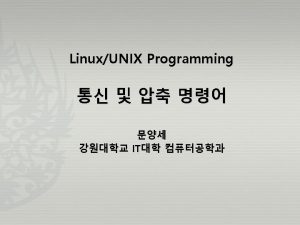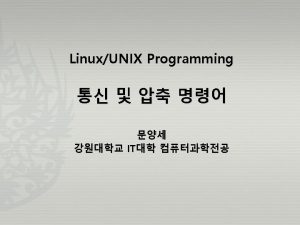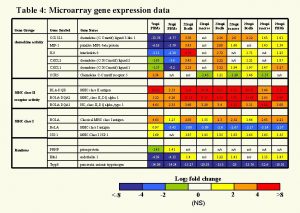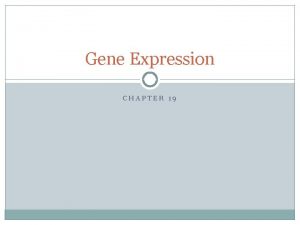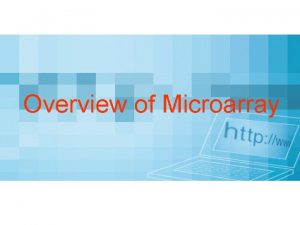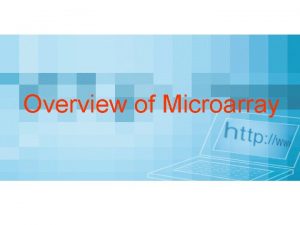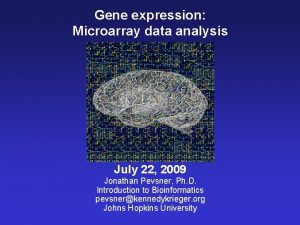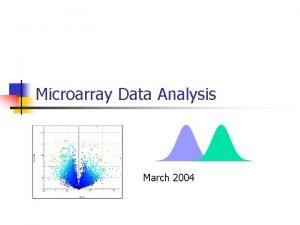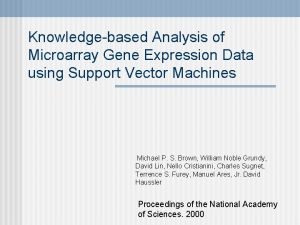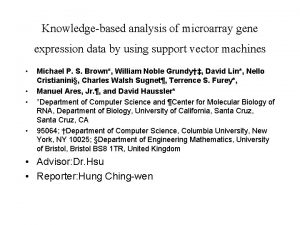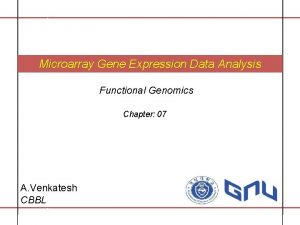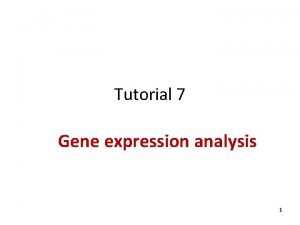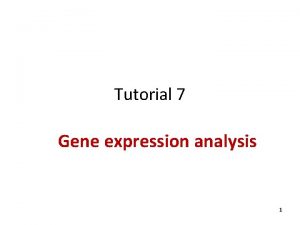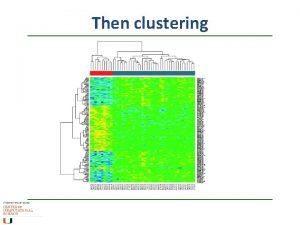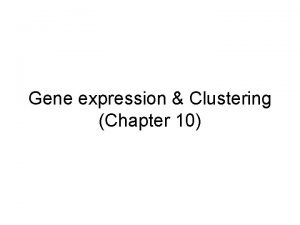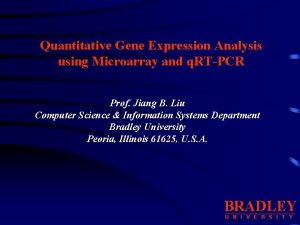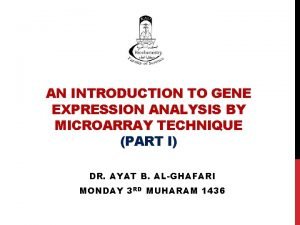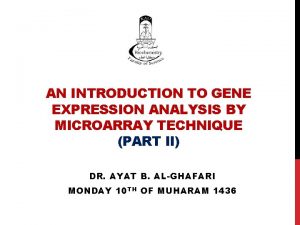Clustering analysis of microarray gene expression data Ping









































![Transition Profiles indicator[n] = (A[n-1] – A[n]) / (A[n] – A[n+1]) A[k] is the Transition Profiles indicator[n] = (A[n-1] – A[n]) / (A[n] – A[n+1]) A[k] is the](https://slidetodoc.com/presentation_image_h/0cc2498af9462e029963a4b8148d10f3/image-42.jpg)
![Reference l [1] Ying Xu, Victor Olman, and Dong Xu. Clustering Gene Expression Data Reference l [1] Ying Xu, Victor Olman, and Dong Xu. Clustering Gene Expression Data](https://slidetodoc.com/presentation_image_h/0cc2498af9462e029963a4b8148d10f3/image-43.jpg)

- Slides: 44

Clustering analysis of microarray gene expression data Ping Zhang November 19 th, 2008

Outline l Gene expression l Similarity between gene expression profiles l Concept of clustering l K-Means clustering l Hierarchical clustering l Minimum spanning tree-based clustering

What is a DNA Microarray? DNA microarray technology allows measuring expressions for tens of thousands of genes at a time

Scanning/Signal Detection Cy 3 channel Cy 5 channel equal expression higher expression in Cy 3 higher expression in Cy 5

Data-flow schema of microarray data analysis

Outline l Gene expression l Similarity between gene expression profiles l Concept of clustering l K-Means clustering l Hierarchical clustering l Minimum spanning tree-based clustering

Gene expression profiles Expression (relatively levels to reference point at 0) Time/Condition

Similarity between Profiles Similarity measure: expression ØEuclidean distance ØCorrelation coefficient ØTrend Ø… Correlation coefficient often works better. 0 time Expression profile

Pearson Correlation Coefficient l Compares scaled profiles! l Can detect inverse relationships l Most commonly used n=number of conditions x=average expression of gene x in all n conditions y=average expression of gene y in all n conditions sx=standard deviation of x Sy=standard deviation of y

Correlation Pitfalls Correlation=0. 97

Euclidean Distance l Scaled versus unscaled l Cannot detect inverse relation ships For Gene X=(x 1, x 2, …xn) and Gene Y=(y 1, y 2, …yn)

Outline l Gene expression l Similarity between gene expression profiles l Concept of clustering l K-Means clustering l Hierarchical clustering l Minimum spanning tree-based clustering

Data-Mining through Clustering Assumptions for clustering analysis: v. Expression level of a gene reflects the gene’s activity. v. Genes involved in same biological process exhibit statistical relationship in their expression profiles. Degradation Synthesis Chromatin Glycolysis

Idea of Clustering: group objects into clusters so that o objects in each cluster have “similar” features; o objects of different clusters have “dissimilar” features

Methods of Clustering • discriminant analysis (Fisher, 1931) • K-means (Lloyd, 1948) • hierarchical clustering • self-organizing maps (Kohonen, 1980) • support vector machines (Vapnik, 1985)

Issues in Cluster Analysis l. A lot of clustering algorithms l A lot of distance/similarity metrics l Which clustering algorithm runs faster and uses less memory? l How many clusters after all? l Are the clusters stable? l Are the clusters meaningful?

Which Clustering Method Should I Use? l What is the biological question? l Do I have a preconceived notion of how many clusters there should be? l How strict do I want to be? Spilt or Join? l Can a gene be in multiple clusters? l Hard or soft boundaries between clusters

Outline l Gene expression l Similarity between gene expression profiles l Concept of clustering l K-Means clustering l Hierarchical clustering l Minimum spanning tree-based clustering

K-means clustering for expression profiles Step 1: Transform n (genes) * m (experiments) matrix into n(genes) * n(genes) distance matrix To transform the n*m matrix into n*n matrix, use a similarity (distance) metric. Step 2: Cluster genes based on a k-means clustering algorithm

K-means algorithm The most popular algorithm for clustering What is so attractive? • Simple • Fast • Mathematically correct • Invariant to dimension • Easy to implement

K-Means Clustering l Basic Ideas : using cluster centre (means) to represent cluster l Assigning data elements to the closet cluster (centre). l Goal: Minimize square error (intra-class dissimilarity) : 2 = l There is no hierarchy. l Must supply the number of clusters (k) into which the data are to be grouped.

K-means Clustering : Procedure (1) Initialization 1 Specify the number of cluster k -- for example, k = 4 Expression matrix conditions gene Each point is called “gene”

K-means Clustering : Procedure (2) Initialization 2 Genes are randomly assigned to one of k clusters or choose random starting centers

K-means Clustering : Procedure (3) Calculate the mean of each cluster (6, 7) (1, 2) (3, 4) (3, 2) [(6, 7) + (3, 4) + …]

K-means Clustering : Procedure (4) Each gene is reassigned to the nearest cluster Gene i to cluster c

K-means Clustering : Procedure (5) Iterate until the means are converged

Outline l Gene expression l Similarity between gene expression profiles l Concept of clustering l K-Means clustering l Hierarchical clustering l Minimum spanning tree-based clustering

Hierarchical clustering (1) Step 1: Transform genes * experiments matrix into genes * genes distance matrix Step 2: Cluster genes based on distance matrix and draw a dendrogram until single node remains

Hierarchical clustering (2) 1 2 3 4 5

Hierarchical Clustering Results

Outline l Gene expression l Similarity between gene expression profiles l Concept of clustering l K-Means clustering l Hierarchical clustering l Minimum spanning tree-based clustering

Graph Representation Represent a set of n-dimensional points as a graph o each data point (gene) represented as a node o each pair of genes represented as an edge with a weight defined by the “dissimilarity” between the two genes 0 1 1. 5 2 5 6 7 9 1 0 2 1 6. 5 6 8 8 1. 5 2 0 1 4 4 6 5. 5. . . n-D data points graph representation distance matrix

Minimum Spanning Tree Ø Spanning tree: a sub-graph that has all nodes connected and has no cycles (a) Ø (b) (c) Minimum spanning tree (MST): a spanning tree with the minimum total distance

How to Construct Minimum Spanning Tree Prim’s algorithm and Kruskal’s algorithm Ø step 1: select an edge with the smallest distance from graph Ø step 2: add to tree as along as no cycle is formed Ø step 3: remove the edge from graph Ø step 4: repeat steps 1 -3 till all nodes are connected in tree. 4 8 4 4 4 7 14 5 3 7 10 3 3 3 5 3 6 (a) (b) (c) (d) (e) 5

Foundation of MST Approach Ø Significantly simplifies the data clustering problem, while losing very little essential information for clustering. Ø We have mathematically proved: A multi-dimensional clustering problem is equivalent to a tree-partitioning problem!

Clustering by Cutting Long Edge Hierarchical cutting 1 st cut: longest edge 2 nd 1 cut: second longest edge … Work well for “easy” cases. Produce many clusters with single element for some “difficult” cases. 2

Tree-Based Clustering Ø For each edge, calculate the assessment value Ø Find the edge that give the minimum assessment value as the place to cut g* v. Clustering using iterative method vguarantee to find the global optimality using tree-based dynamic programming

Clustering through Removing Long MST-Edges l Objective: partition an MST into K subtrees so that the total edge-distance of all the K subtrees in minimized l Finding K-1 longest MST-edges and cutting them => we get K clusters l This works as long as the inter-cluster edgedistances are clearly larger than the intra-cluster edge-distances

An Iterative Clustering Algorithm l Find K subtrees Ti of an MST such that to minimize: l Informally, the total distance between the center of each cluster and its data points is minimized The center c of a cluster C is defined as: å the sum of the distances between c and all the data l points in C is minimized l Does not work well if the cluster boundary is not convex

A Globally Optimal Clustering Algorithm l Given an MST T, partition T into K subtrees Ti and find a set of data points di, i = 1…k, di in D such that to minimize: l Informally, group data points around the “best” representatives rather than around the “center” l Using Dynamic Programming for this algorithm

Automated Selection of Number of Clusters Select “transition point” in the assessment value as the“correct” number of clusters.
![Transition Profiles indicatorn An1 An An An1 Ak is the Transition Profiles indicator[n] = (A[n-1] – A[n]) / (A[n] – A[n+1]) A[k] is the](https://slidetodoc.com/presentation_image_h/0cc2498af9462e029963a4b8148d10f3/image-42.jpg)
Transition Profiles indicator[n] = (A[n-1] – A[n]) / (A[n] – A[n+1]) A[k] is the assessment value for partition with k clusters Our clustering of yeast data
![Reference l 1 Ying Xu Victor Olman and Dong Xu Clustering Gene Expression Data Reference l [1] Ying Xu, Victor Olman, and Dong Xu. Clustering Gene Expression Data](https://slidetodoc.com/presentation_image_h/0cc2498af9462e029963a4b8148d10f3/image-43.jpg)
Reference l [1] Ying Xu, Victor Olman, and Dong Xu. Clustering Gene Expression Data Using a Graph-Theoretic Approach: An Application of Minimum Spanning Trees. Bioinformatics. 18: 526 -535, 2002. l [2] Dong Xu, Victor Olman, Li Wang, and Ying Xu. EXCAVATOR: a computer program for gene expression data analysis. Nucleic Acid Research. 31: 5582 -5589. 2003. l Using slides from: Michael Hongbo Xie, Temple University (in 2006) Vipin Kumar, University of Minnesota Dong Xu, University of Missouri

Acknowledgement
 Chapter 17 gene expression from gene to protein
Chapter 17 gene expression from gene to protein Flat clustering vs hierarchical clustering
Flat clustering vs hierarchical clustering Bond energy algorithm
Bond energy algorithm Rumus euclidean distance
Rumus euclidean distance Microarray data analysis tutorial
Microarray data analysis tutorial Dna rna protein
Dna rna protein Microarray data normalization and transformation
Microarray data normalization and transformation Gene by gene test results
Gene by gene test results Poltrp
Poltrp Prokaryotic
Prokaryotic Regulation of gene expression in bacteria
Regulation of gene expression in bacteria Chapter 18 regulation of gene expression
Chapter 18 regulation of gene expression Chapter 18 regulation of gene expression
Chapter 18 regulation of gene expression Regulation of gene expression
Regulation of gene expression טרנסלציה
טרנסלציה Chapter 18 regulation of gene expression
Chapter 18 regulation of gene expression Genetic effects on gene expression across human tissues
Genetic effects on gene expression across human tissues Negative control
Negative control Ch 18+
Ch 18+ Gapdh size
Gapdh size Gene expression omnibus tutorial
Gene expression omnibus tutorial Gene expression
Gene expression Gene expression
Gene expression Gene expression
Gene expression Gene expression
Gene expression Gene regulation
Gene regulation Cells must control gene expression so that __________.
Cells must control gene expression so that __________. Lyonization of gene expression
Lyonization of gene expression Uses of dna microarray
Uses of dna microarray Methylation & chip-on-chip microarray platform
Methylation & chip-on-chip microarray platform G c a t dna
G c a t dna Dna hybridization microarray
Dna hybridization microarray Protein microarray
Protein microarray Dna microarray
Dna microarray Microarray
Microarray Hetrozigot
Hetrozigot Amprenta genetica
Amprenta genetica Microarray types
Microarray types Minimum information about a microarray experiment
Minimum information about a microarray experiment Microarray
Microarray Quadratic equation examples
Quadratic equation examples Clustering by passing messages between data points
Clustering by passing messages between data points Classification and clustering in data mining
Classification and clustering in data mining Clustering non numeric data
Clustering non numeric data Birch in data mining
Birch in data mining




